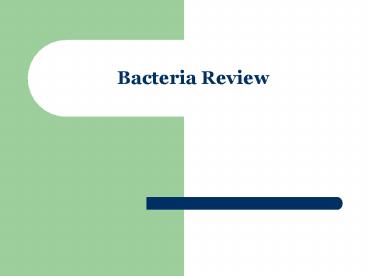Bacteria Review - PowerPoint PPT Presentation
1 / 41
Title:
Bacteria Review
Description:
Thermoacidophiles: very hot and acidic. Halophiles. Thermophiles ... bacilli rod-shaped. cocci round. spirilla spiral / corkscrew. Materials in Cell Wall: ... – PowerPoint PPT presentation
Number of Views:78
Avg rating:3.0/5.0
Title: Bacteria Review
1
Bacteria Review
2
Kingdoms
- Organisms are classified into six different
kingdom. - Two of the kingdoms, classify organisms that we
know as bacteria. - They are Eubacteria and Archaebacteria.
3
Both Kingdoms have the following characteristics
- Unicellular
- Prokaryotes
- Cell walls
- Heterotrophs or Autotrophs
4
Differences between the kingdomsEubacteria
- Cell walls contain a carbohydrate called
peptidoglycan. It makes the wall strong and
thick. - Live almost everywhere!
5
(No Transcript)
6
Archaebacteria
- Cell walls do not contain peptidoglycan.
- Live in environments that are harsh
- Methanogens produce methane gas
- Halophiles very salty
- Thermoacidophiles very hot and acidic
7
Halophiles
8
Thermophiles
9
Methanogens Produce Methane Gas
10
Bacteria are
- The smallest of all living organisms.
- A very diverse group.
- So how do we group or classify such a microscopic
and vast group?
11
Bacteria are classified by
- Shape
- bacilli rod-shaped
- cocci round
- spirilla spiral / corkscrew
- Materials in Cell Wall
- have thick peptidoglycan - Gram-positive
- have thin peptidoglycan Gram-negative
- have no peptidoglycan
12
Bacteria are classified by
- Movement
- No movement
- Movement with flagella, spiral motion or slime
layer - How they obtain food and use energy
- Chemoheterotrophs take in food for energy and
carbon. - Photoheterotrophs is photosynthetic but needs
organic compounds for carbon. - Chemoautotrophs make carbon molecules from CO2
using energy from chemical reactions - Photoautotrophs use sunlight to change CO2 and
water to carbon compounds
13
Bacteria are classified by
- What sort of environment they need
- Rich in oxygen
- Obligate aerobes
- Without oxygen or lacks oxygen
Obligate anaerobes - OR they can live with or without oxygen
- Facultative anaerobes
14
Gram Staining
- Scientists have developed a method of staining to
determine what materials are in the cell wall. - This procedure is called Gram Staining.
- Two different stains are applied to a cell. How
each cell absorbs the stains tells us what type
of materials are in the cell wall.
15
Process of Gram Staining
- First, bacteria on a glass slide are stained with
a violet stain. - Then, the slide is washed with alcohol.
- Finally, the slide is stained with a red stain.
16
(No Transcript)
17
Gram Positive Results
- If the cell wall absorbs the violet stain, the
cell is classified as Gram . - This means the cell wall contains peptidoglycan
and is very strong and thick.
18
Gram Absorbs violet stain.
19
Typical Gram-positive bacteria
- Staphylococcus epidermidis and Staphylococcus
aureus which is a common cause of boils - Streptococcus pyogenes which causes many a sore
throat and scarlet fever and Streptococcus
pneumoniae which causes lobar pneumonia - Clostridium tetani which cause tetanus (lockjaw)
- Actinomyces odontolyticus which is found in
mouths - Bacillus subtilis which are common microbes
living in soil
20
Gram Negative Results
- The violet stain is not absorbed.
- The alcohol wash DISSOLVES the lipids in the cell
wall. - Then, the cell absorbs the red stain.
21
Gram - absorbs red dye.
22
Typical Gram-negative bacteria
- whooping cough, Bordetella pertussis
- typhoid, Salmonella typhi
- cholera, Vibrio cholerae
23
- Why do we need to know what is in the cell wall?
24
- Some cell walls protect the bacteria from being
affected by antibiotics. - If a doctor knows what type of cell wall the
bacteria has, he will prescribe medicine that
will get through the cell wall!!
25
SHAPES
- Bacilli
26
Cocci
27
- Spirilla
28
- Strepto bacteria cluster in rows
- Staphylo bacteria cluster in grape-like clusters
29
A bacterial model contains the following
structures
- A cell wall with or without peptidoglycan
- A cell membrane
- Cytoplasm
- Ribosomes
- A circle of DNA
- Structures for movement
- And Pili
- Structures that help connect 2 bacteria during
the exchange of genetic material.
30
Model of a Bacterium
31
Reproduction Binary Fission
- Asexual
- One bacterium divides into two daughter bacteria.
- Each new daughter is IDENTICAL to the parent.
32
Two daughter cells are about to separate by
cytokinesis.
33
How do bacteria with in a species become diverse?
- Conjugation!
- Hollow structures, called pili, connect two
bacteria. - Genetic material is exchanged through this
structure.
34
Conjugation Model
35
What is the result of conjugation?
36
GENETIC DIVERSITY!
- After conjugation is complete, each bacterium has
a new combination of base sequences - This sequence is completely different then the
sequences either bacterium had in the beginning.
37
Why is diversity important?
38
It ensures that the bacteria will
- Survive in a difficult environment.
- Reproduce and pass their genes to the next
generation.
39
Spore Formation
- In unfavorable conditions, endospores form
- Endospores are like tough shells enclosing the
nucleus of bacterial DNA - In favorable conditions, they germinate and grow
Clostridium botulinum
40
We can not live without Bacteria!
- They are everywhere!
- They are in us!
- They are on us!
- They help us in millions of ways!
41
Roles of Bacteria
- Clean the water in the mining of gold.
- Make artificial snow.
- Bleach wood pulp white.
- Give flavor to food.
- Decompose dead organic material.
- Produce antibiotics and medicines.
- Recycle nitrogen in the nitrogen cycle.
- Cause diseases.
42
Bacteria causes disease two ways
- They actually eat the cell they affect.
- Example Tuberculosis in the lungs.
- They produce toxins that poison the cell they
affect. - Example Botulism (food poisoning caused by nerve
toxin)































